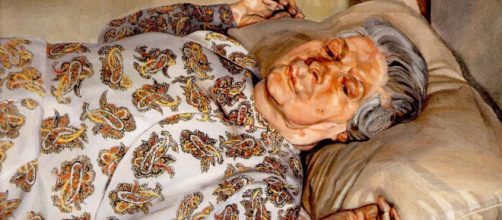It leaps out from the family photos and letters in the Lucian Freud exhibit “The Painter and His Family” at the Freud Museum in London. Particularly noticeable is the portrait of the artist's mother.
What’s so special about the portrait? Look and see if it doesn’t have the Oedipus Complex written all over it. (More about this in a moment).
The disorder was identified by Lucian’s grandfather Sigmund Freud in his book “Interpretation of Dreams.” To hear the good doctor tell it, little boys have an unconscious sexual desire for their mothers that may be the source of an adult personality disorder.
No small thing, his theory is the main idea behind psychoanalysis.
Don’t shoot pose
The portrait brings the Oedipus complex to mind. How else to explain why Lucian posed his mother flat on her back in bed, fully clothed, with her arms raised, as if in surrender.
She appears to know what is going on. Her eyes are open, watching her son as he arranges the scene of a pliant, servile woman – a picture of abject passivity.
The pose suggests such subjection that you find yourself wondering why she allowed herself to model so much helplessness.
Mama Freud’s look of powerlessness conjures up the photo on the cover of the Lucian bio by William Feaver. The artist, famed as a womanizer, stands in the foreground with his arms folded across his chest, self-assured while a young female crouch on the floor in the background.
If his grandfather was right and the Oedipus Complex is the source of an adult personality disorder, you’re looking at it on that book cover photo.
In the DNA
But wait, there may be another explanation for both the chauvinist book cover and the controlling image of Mama Freud besides the Oedipus Complex – like say, genetics.
I’m thinking of Sigmund’s disdain for women seen in his 1925 dissertation “The Psychical Consequences of the Anatomical Distinction Between the Sexes.” One line sums up the disdain:
“Women oppose change, receive passively, and add nothing of their own.”
Somewhere in the process of studying Lucian’s portrait of his mother, I thought of Alfred Hitchcock’s 1960 film “Psycho.” Of course, Lucian was no Norman Bates, but by the look of his portrait of his mother, it’s fair to say his relationship with her was bizarre.
I mean, who paints his mother like that?
Granted, James Abbott McNeill Whistler pictured his mother in an oddly cold way, too. He didn’t even mean it to be about her, having titled his picture “Arrangement in Gray and Black.” To get Mama Whistler to pose like a motif, you imagine him telling her: “Be quiet, Mom. This isn’t about you.”
An exhibit label accompanying Lucian’s mommy portrait says: “Here’s my mother. That is what she looked like” with the titled “The Painter’s Mother Resting.” “Resting”? Submitting is more like it.
While the mother-son relationship at the Freud house didn’t turn Lucian into a psychopath, he did have three troubled marriages and he fathered 14 children – most from various mistresses. I’m just saying.


